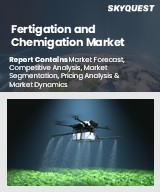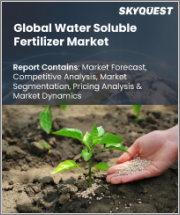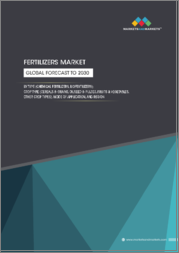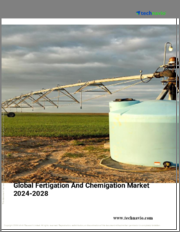
|
시장보고서
상품코드
1629341
관비 및 화학제관개 시장 : 농업 투입물별, 작물 유형별, 용도별, 관개 유형별, 지역별, 기회, 예측(2018-2032년)Fertigation and Chemigation Market Assessment, By Agricultural Input, By Crop Type, By Application, By Irrigation Type, By Region, Opportunities and Forecast, 2018-2032F |
||||||
세계 관비 및 화학제관개 시장 규모는 2025-2032년 예측 기간 동안 5.51%의 CAGR로 2024년 481억 1,000만 달러에서 2032년 738억 9,000만 달러로 성장할 것으로 예상됩니다. 이 시장은 효율적인 농업 관행과 지속가능한 자원 활용에 대한 수요 증가로 인해 성장하고 있습니다. 관비는 관개 시스템을 통해 비료를 살포하는 것을 의미하며, 화학제관개는 살충제나 제초제와 같은 화학제품을 살포하는 것을 말합니다. 인구 증가와 식생활 선호도 변화는 세계 식량 수요 증가의 원인이 되고 있으며, 작물 수확량 증가와 농업 생산성 향상에 대한 요구가 시장 성장에 기여하고 있습니다.
관비 및 화학제관개의 주요 장점은 물 낭비를 줄이고, 인건비를 절감하며, 가뭄에 대한 내성을 증가시켜 현대 농업에 매력적으로 작용하고 있습니다. 시장은 특히 유럽과 같은 지역에서 강세를 보이고 있으며, 자원 최적화를 위한 정부의 노력과 보조금으로 인해 사용이 증가하고 있어 가장 광범위한 CAGR이 예상되는 분야이기도 합니다.
농업에서 기계화 기술 적용의 지속적인 발전은 농부들이 환경 파괴를 줄이면서 영양분 살포량을 늘리려는 노력으로 시장을 확대시키고 있습니다. 이러한 장점에 대한 농부들의 인식이 높아짐에 따라, 향후 몇 년 동안 시비 관개 및 약품 혼합 관개 시장은 신흥 시장으로 부상할 것으로 예상됩니다.
이 보고서는 세계 관비 및 화학제관개 시장에 대해 조사했으며, 시장 개요와 함께 농업 투입물별, 작물 유형별, 용도별, 관개 유형별, 지역별 동향, 시장 진입 기업 프로파일 등을 제공합니다.
목차
제1장 프로젝트 범위와 정의
제2장 조사 방법
제3장 주요 요약
제4장 고객의 소리
제5장 세계의 관비 및 화학제관개 시장 전망, 2018-2032년
- 시장 규모 분석과 예측
- 시장 점유율 분석과 예측
- 시장 맵 분석, 2024년
- 농업 투입량별
- 작물 유형별
- 용도별
- 관개 유형별
- 지역별
제6장 북미의 관비 및 화학제관개 시장 전망, 2018-2032년
제7장 유럽의 관비 및 화학제관개 시장 전망, 2018-2032년
제8장 아시아태평양의 관비 및 화학제관개 시장 전망, 2018-2032년
제9장 남미의 관비 및 화학제관개 시장 전망, 2018-2032년
제10장 중동 및 아프리카의 관비 및 화학제관개 시장 전망, 2018-2032년
제11장 규제 상황
제12장 수요 공급 분석
제13장 수출입 분석
제14장 밸류체인 분석
제15장 Porter's Five Forces 분석
제16장 PESTLE 분석
제17장 거시경제 지표
제18장 가격 분석
제19장 이익률 분석
제20장 시장 역학
제21장 시장 동향과 발전
제22장 사례 연구
제23장 경쟁 구도
- 시장 리더 탑 5 경쟁 매트릭스
- 기업 생태계 분석(스타트업 vs 중소기업 vs 대규모 기업)
- 진출 기업 탑 5 SWOT 분석
- 시장 진출 기업 탑 10 상황
- The Toro Company
- Netafim Ltd.
- Rain Bird Corporation
- Lindsay Corporation
- Jain Irrigation Systems Limited
- T-L IRRIGATION CO.
- Rivulis Irrigation Ltd.
- Hunter Industries, Inc.
- SISTEMA AZUD, SA
- Chinadrip Irrigation Equipment(Xiamen) Co.,Ltd.
제24장 전략적 제안
제25장 문의와 면책사항
ksm 25.01.20Global fertigation and chemigation market is projected to witness a CAGR of 5.51% during the forecast period 2025-2032, growing from USD 48.11 billion in 2024 to USD 73.89 billion in 2032. The market is growing owing to rising demand for efficient agricultural practices and sustainable resource usage. Fertigation refers to the application of fertilizers through irrigation systems, and chemigation is the application of chemicals such as pesticides and herbicides through similar methods. Increasing population and changes in dietary preference are responsible for the increasing global food demands that necessitate growing crop yields and improved agricultural productivity, contributing to market growth.
Key benefits of fertigation and chemigation are reduced water waste, lower labor costs, and increased resistance to droughts, making these methods attractive for modern farming. The market is particularly strong in regions like Europe, where it is also expected to be the segment attracting the most extensive CAGR due to increasing use brought about by government initiatives and subsidies toward resource optimization.
Sustained advancement of mechanized technology application in agriculture has widened the market as farmers seek to enrich the application of nutrients while reducing environmental degradation. The awareness of these benefits is growing among farmers, and hence the fertigation and chemigation market is expected to witness developments in the years to come.
In June 2023, a new range of advanced fertigation products was introduced in North America under the Nova brand name by ICL, owned by Everris International B.V. The goal is to supply crops with high-quality, water-soluble N-P-Ks (Nitrogen, Phosphorus, and Potassium) and micronutrients. Nova FINISH, Nova PULSE, Nova ELEVATE, and Nova FLOW are among the varieties. These products are developed to achieve maximum solubility and good compatibility with the majority of herbicides and crop protectants, with the primary goal of more effectively delivering crop nutrients to the targeted site of action.
Rising Awareness Catalyzes Market Expansion
Growing awareness of sustainable agricultural practices is, increasingly and prominently, spurring on the development of the global market for fertigation and chemigation. An increasing number of farmers and other stakeholders are acknowledging the merits gained from enhanced nutrient delivery and reduced environmental footprint, leading to higher adoption rates.
Fertigation and chemigation offer a better opportunity to deliver fertilizers and chemicals into plants through irrigation systems while ensuring precise application in the crop for leaching and runoff control. Benefits include higher yields and better quality produce, making both methods popular among farmers desiring to increase productivity as demand for food increases.
Moreover, the government schemes and initiatives further encourage the trend of adopting advanced irrigation techniques for the effective use of water for agricultural needs. Overall, an increased perception of the benefits associated with fertigation and chemigation is driving their incorporation in modern-day agriculture worldwide, making them part of sustainable farming.
In September 2023, AGRIVI Ltd. introduced a new module for fertigation management that improves crop sustainability and yield. The module is designed mostly for greenhouse-grown vegetables and berries on substrate, which completely changes how crops are grown.
Increasing Food Demand Influences the Market Growth
The growing demand for food drives growth in the fertigation and chemigation market. The need for efficient agricultural practices has become more necessary as the global population increases. Fertigation, by way of delivering fertilizers through some irrigation system and chemigation, that applies chemicals like pesticides through similar means, allows farmers the possibility to respond to their demand more effectively. Both of these techniques enhance nutrient use efficiency and waste minimization, with consequent improvements in crop productivity possible under lower resource inputs.
According to the WFP 2025 Global Outlook, an estimated 343 million people in the 74 countries where the United Nations World Food Programme (WFP) works are acutely food insecure, which is 10% higher than in 2023 and about 200 million more than prior to the pandemic. In 2024, an estimated 1.9 million people-mostly in Gaza and Sudan but also in Haiti, Mali, and some areas of South Sudan-are at risk of starvation.
Changes in urbanization or preferences in dietary habits demand a larger increase in food production. Governments are also involved in these progressive improvements through subsidies and initiatives that support agricultural sustainability.
Drip Irrigation Holds the Dominant Market Share
The share of drip irrigation in the fertigation and chemigation market will continue to dominate even during the forecast period. This technique is preferred due to its efficiency in supplying water and nutrients directly to the root zone of the plants, which increases the absorption by minimizing wastage. The very precise drip irrigation systems enable targeted application using considerably reduced fertilizer loss but maintaining optimum moisture levels in the crops.
The growing awareness of water conservation and sustainable agricultural practices further boosts the adoption of drip irrigation. As climate change exacerbates the water scarcity issue, farmers rapidly embrace drip systems to improve yields using fewer resources. Such a trend also leverages government initiatives encouraging the adoption of advanced irrigation technologies. In March 2024, a new chemigation bill was passed for Idaho-based chemigators. As per the new bill, chemigators no longer need to replicate the licensing procedure and examinations for pesticide applicators in order to obtain a license; instead, they can now choose to participate in an ISDA program, either in person or online. Previously, regardless of whether they were using fertilizer or pesticides, all chemigators had to get a pesticide applicator license.
Cost-effective for farmers, drip irrigation has lower labor costs than conventional methods and better fertilizer management. The drip irrigation segment remains on track for further growth as it is cemented by best-in-class performance and environmental advantages as being the most preferred technique in the fertigation and chemigation market.
Europe Dominates the Market
The fertigation and chemigation market is dominated by Europe, and is expected to continue during the forecast period. The domination is accounted for by the growing population and the increasing demand for high-quality crops in the region. The processes of fertigation and chemigation are especially efficient for nutrient application, where the loss by leaching is significantly reduced, and there is an improvement in the yield and quality of the crops.
In May 2024, Wiseconn Engineering, Inc., a precision irrigation firm based in California, introduced its RF-V1 field device in Europe to broaden its product line. This device is intended to make controlling the valves in its DropControl irrigation system easier. Users are able to better manage water resources and adjust to the effects of climate change with the help of the company's unique DropControl technology. The improved functionality of proprietary DropControl technology satisfies all requirements in the fertigation and irrigation fields.
Moreover, countries in Europe, such as Germany, the UK, France, and Spain, invest in research and adopt changes to improve production and welfare. The challenges of diminishing farmland and the changeability of the climate, among others, are also affecting the natural resource landscape of agriculture in Europe and forcing farmers to devise innovative practices to maintain productivity.
Future Market Scenario (2025 - 2032F)
Innovation in fertigation and chemigation systems is slated to bring about improvement in their efficiency and efficacy.
Developing government promotions on these technologies with the increasing demand for agricultural productivity due to population growth shall hence give bullish market opportunities for players across the regions.
The fertigation and chemigation market in developing countries is expected to expand rapidly due to the increasing demand for agricultural production.
Key Players Landscape and Outlook
The fertigation and chemigation industry is a competitive one, with several leading players engaged in proactive efforts toward product innovation, research, and development. Companies are striving to boost their own market presence through alliances, mergers, and acquisitions to enhance their technological capabilities and offerings. Moreover, the thrust of sustainability has brought about the need for these players to embrace advanced irrigation technologies to optimize resource use and minimize the effects on the environment.
Furthermore, major companies are spending huge amounts on R&D in efficacious fertigation and chemigation systems to meet the needs of a growing population for high-quality crops. On the other hand, local players are getting a foothold by introducing cost-effective solutions customized for specific regional practices.
The market outlook appears to be positive due to the demand for the significant demand, leading to the adoption of precision agriculture technologies within the global food market. Awareness of fertigation and chemigation will also be beneficial to a change in the competitive dynamics of very well-known companies, with budding ones for a share in this quickly emerging market.
Table of Contents
1. Project Scope and Definitions
2. Research Methodology
3. Executive Summary
4. Voice of Customer
- 4.1. Demographics (Income - Low, Mid and High; Geography; Nationality; etc.)
- 4.2. Market Awareness and Product Information
- 4.3. Brand Awareness and Loyalty
- 4.4. Factors Considered in Purchase Decision
- 4.4.1. Effectiveness
- 4.4.2. Cost
- 4.4.3. Environmental Impact
- 4.4.4. Health Concerns
- 4.4.5. Regulations
- 4.4.6. Availability
- 4.4.7. Recommendations
- 4.4.8. Brand Reputation
- 4.4.9. Ease of Use
- 4.4.10. Resistance Management
- 4.5. Purchase Channel
- 4.6. Frequency of Purchase
- 4.7. Existing or Intended User
5. Global Fertigation and Chemigation Market Outlook, 2018-2032F
- 5.1. Market Size Analysis & Forecast
- 5.1.1. By Value
- 5.2. Market Share Analysis & Forecast
- 5.2.1. By Agricultural Input
- 5.2.1.1. Fertilizers
- 5.2.1.2. Insecticides
- 5.2.1.3. Herbicides
- 5.2.1.4. Fungicides
- 5.2.1.5. Others
- 5.2.2. By Crop Type
- 5.2.2.1. Cereals and Grains
- 5.2.2.2. Oilseeds and Pulses
- 5.2.2.3. Fruits and Vegetables
- 5.2.2.4. Others
- 5.2.3. By Application
- 5.2.3.1. Agricultural Irrigation
- 5.2.3.2. Greenhouse Irrigation
- 5.2.3.3. Landscape Irrigation
- 5.2.3.4. Others
- 5.2.4. By Irrigation Type
- 5.2.4.1. Drip Irrigation
- 5.2.4.2. Sprinkler Irrigation
- 5.2.4.3. Others
- 5.2.5. By Region
- 5.2.5.1. North America
- 5.2.5.2. Europe
- 5.2.5.3. Asia-Pacific
- 5.2.5.4. South America
- 5.2.5.5. Middle East and Africa
- 5.2.6. By Company Market Share Analysis (Top 5 Companies and Others - By Value, 2024)
- 5.2.1. By Agricultural Input
- 5.3. Market Map Analysis, 2024
- 5.3.1. By Agricultural Input
- 5.3.2. By Crop Type
- 5.3.3. By Application
- 5.3.4. By Irrigation Type
- 5.3.5. By Region
6. North America Fertigation and Chemigation Market Outlook, 2018-2032F*
- 6.1. Market Size Analysis & Forecast
- 6.1.1. By Value
- 6.2. Market Share Analysis & Forecast
- 6.2.1. By Agricultural Input
- 6.2.1.1. Fertilizers
- 6.2.1.2. Insecticides
- 6.2.1.3. Herbicides
- 6.2.1.4. Fungicides
- 6.2.1.5. Others
- 6.2.2. By Crop Type
- 6.2.2.1. Cereals and Grains
- 6.2.2.2. Oilseeds and Pulses
- 6.2.2.3. Fruits and Vegetables
- 6.2.2.4. Others
- 6.2.3. By Application
- 6.2.3.1. Agricultural Irrigation
- 6.2.3.2. Greenhouse Irrigation
- 6.2.3.3. Landscape Irrigation
- 6.2.3.4. Others
- 6.2.4. By Irrigation Type
- 6.2.4.1. Drip Irrigation
- 6.2.4.2. Sprinkler Irrigation
- 6.2.4.3. Others
- 6.2.5. By Country Share
- 6.2.5.1. United States
- 6.2.5.2. Canada
- 6.2.5.3. Mexico
- 6.2.1. By Agricultural Input
- 6.3. Country Market Assessment
- 6.3.1. United States Fertigation and Chemigation Market Outlook, 2018-2032F*
- 6.3.1.1. Market Size Analysis & Forecast
- 6.3.1.1.1. By Value
- 6.3.1.2. Market Share Analysis & Forecast
- 6.3.1.2.1. By Agricultural Input
- 6.3.1.2.1.1. Fertilizers
- 6.3.1.2.1.2. Insecticides
- 6.3.1.2.1.3. Herbicides
- 6.3.1.2.1.4. Fungicides
- 6.3.1.2.1.5. Others
- 6.3.1.2.2. By Crop Type
- 6.3.1.2.2.1. Cereals and Grains
- 6.3.1.2.2.2. Oilseeds and Pulses
- 6.3.1.2.2.3. Fruits and Vegetables
- 6.3.1.2.2.4. Others
- 6.3.1.2.3. By Application
- 6.3.1.2.3.1. Agricultural Irrigation
- 6.3.1.2.3.2. Greenhouse Irrigation
- 6.3.1.2.3.3. Landscape Irrigation
- 6.3.1.2.3.4. Others
- 6.3.1.2.4. By Irrigation Type
- 6.3.1.2.4.1. Drip Irrigation
- 6.3.1.2.4.2. Sprinkler Irrigation
- 6.3.1.2.4.3. Others
- 6.3.1.2.1. By Agricultural Input
- 6.3.1.1. Market Size Analysis & Forecast
- 6.3.2. Canada
- 6.3.3. Mexico
- 6.3.1. United States Fertigation and Chemigation Market Outlook, 2018-2032F*
All segments will be provided for all regions and countries covered
7. Europe Fertigation and Chemigation Market Outlook, 2018-2032F
- 7.1. Germany
- 7.2. France
- 7.3. Italy
- 7.4. United Kingdom
- 7.5. Russia
- 7.6. Netherlands
- 7.7. Spain
- 7.8. Turkey
- 7.9. Poland
8. Asia-Pacific Fertigation and Chemigation Market Outlook, 2018-2032F
- 8.1. India
- 8.2. China
- 8.3. Japan
- 8.4. Australia
- 8.5. Vietnam
- 8.6. South Korea
- 8.7. Indonesia
- 8.8. Philippines
9. South America Fertigation and Chemigation Market Outlook, 2018-2032F
- 9.1. Brazil
- 9.2. Argentina
10. Middle East and Africa Fertigation and Chemigation Market Outlook, 2018-2032F
- 10.1. Saudi Arabia
- 10.2. UAE
- 10.3. South Africa
11. Regulatory Landscape
12. Demand Supply Analysis
13. Import and Export Analysis
14. Value Chain Analysis
15. Porter's Five Forces Analysis
16. PESTLE Analysis
17. Macro-economic Indicators
18. Pricing Analysis
19. Profit Margin Analysis
20. Market Dynamics
- 20.1. Market Drivers
- 20.2. Market Challenges
21. Market Trends and Developments
22. Case Studies
23. Competitive Landscape
- 23.1. Competition Matrix of Top 5 Market Leaders
- 23.2. Company Ecosystem Analysis (Startup v/s SME v/s Large-scale)
- 23.3. SWOT Analysis for Top 5 Players
- 23.4. Key Players Landscape for Top 10 Market Players
- 23.4.1. The Toro Company
- 23.4.1.1. Company Details
- 23.4.1.2. Key Management Personnel
- 23.4.1.3. Products and Services
- 23.4.1.4. Financials (As Reported)
- 23.4.1.5. Key Market Focus and Geographical Presence
- 23.4.1.6. Recent Developments/Collaborations/Partnerships/Mergers and Acquisition
- 23.4.2. Netafim Ltd.
- 23.4.3. Rain Bird Corporation
- 23.4.4. Lindsay Corporation
- 23.4.5. Jain Irrigation Systems Limited
- 23.4.6. T-L IRRIGATION CO.
- 23.4.7. Rivulis Irrigation Ltd.
- 23.4.8. Hunter Industries, Inc.
- 23.4.9. SISTEMA AZUD, SA
- 23.4.10. Chinadrip Irrigation Equipment (Xiamen) Co.,Ltd.
- 23.4.1. The Toro Company
Companies mentioned above DO NOT hold any order as per market share and can be changed as per information available during research work.



















